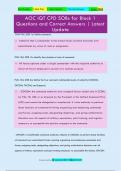Best Grades | Must Pass | Latest Update | Correct Answers | 2024/ 2025
AOC IQT CPD SOBs for Block 1
Questions and Correct Answers | Latest
Update
FUN-104, SOB 1a: Define command.
Authority that a commander in the armed forces lawfully exercises over
subordinates by virtue of rank or assignment.
FUN-104, SOB 1b: Identify the principle of unity of command.
All forces operate under a single commander with the requisite authority to
direct all forces employed in pursuit of a common purpose.
FUN-104, SOB 2a: Define the four command relationship levels of authority (COCOM,
OPCON, TACON, and Support).
- COCOM: the command authority over assigned forces vested only in CCDRs
by Title 10, USC or as directed by the President in the Unified Command Plan
(UCP) and cannot be delegated or transferred. It is the authority to perform
those functions of command involving organizing and employing commands
and forces, assigning tasks, designating objectives, and giving authoritative
direction over all aspects of military operations, joint traini ng, and logistics
necessary to accomplish the missions assigned to the command.
- OPCON: a transferable command authority, inherent in COCOM, to perform those functions
of command over subordinate forces involving organizing and employing commands and
forces, assigning tasks, designating objectives, and giving authoritative direction over all
aspects of military operations and joint training necessary to accomplish the mission. OPCON
for inquiry mail me @ supergrades12@gmail.com
, Best Grades | Must Pass | Latest Update | Correct Answers | 2024/ 2025
normally provides full authority to organize commands and forces and employ those forces,
but it does not include authoritative direction for logistics or matters of administration,
discipline, internal organization, or unit training.
- TACON: a transferable command authority, inherent in OPCON, over assigned or attached
forces or commands, or military capability or forces made available for tasking. The authority
is limited to the detailed direction and control of movements or maneuvers within the
Operational Area (OA) necessary to accomplish assigned missions or tasks.
- Support: a command authority established by a superior commander between subordinate
commanders when one organization should aid, protect, complement, or sustain another force.
The designation of supporting relationships is important as it conveys priorities to commanders
and staffs that are planning or executing joint operations.
FUN-104, SOB 2b: Define the additional levels of authority (ADCON, coordinating authority,
DIRLAUTH).
- ADCON: the direction or exercise of authority over subordinate or othe r
organizations with respect to administration and support including
organization of Service forces, control of resources and equipment, personnel
management, unit logistics, individual and unit training, readiness,
mobilization, demobilization, discipline , and other matters not included in the
operational missions of the subordinate or other organizations.
- Coordinating Authority: Authority delegated to a commander or individual for coordinating
specific functions and activities involving forces of two or more Services, two or more joint
force components, or two or more forces of the same Service. The commander or individual
for inquiry mail me @ supergrades12@gmail.com
, Best Grades | Must Pass | Latest Update | Correct Answers | 2024/ 2025
has the authority to require consultation between the agencies involved, but does not have the
authority to compel agreement.
- DIRLAUTH: that authority granted by a commander (at any level) to a subordinate to directly
consult or coordinate an action with a command or agency within or outside the granting
command. It is more applicable to planning than operations, and always carries with it the
requirement of keeping the granting commander informed. DIRLAUTH is a coordination
relationship, not an authority through which command may be exercised. (JP-1, p V-12, para
9.c.)
FUN-104, SOB 3a: Identify the levels of authority normally exercised by the COMAFFOR.
OPCON & ADCON
FUN-104, SOB 3b: Identify the level of authority normally exercised by a JFACC.
TACON
FUN-105, SOB 1a: Identify the two chains of command over Multinational Forces (MNF).
1) a national chain of command
2) a multinational chain of command
FUN-105, SOB 1b: Differentiate between a coalition and an alliance.
- Alliance: the relationship that results from a formal agreement (e.g. treaty)
between two or more nations for broad, long -term objectives that further the
common interests of the members.
for inquiry mail me @ supergrades12@gmail.com
, Best Grades | Must Pass | Latest Update | Correct Answers | 2024/ 2025
- Coalition: an ad hoc arrangement between two or more nations for common action.
Coalitions are formed by different nations, often with different objectives, usually for a single
occasion or for a longer period while addressing a narrow sector of common interest.
FUN-105, SOB 1c: Describe the three basic command structure models.
- Parallel Command Structure: Each coalition member has its own command
chain, working in parallel with the othe r members' chains through some kind of
coordination center. Because no single force commander is designated, this
structure violates the principle of unity of command.
- Lead-nation Command Structure: Exists when one nation, usually the one with the
preponderance of assets and Command and Control (C2) capability, is responsible for the
direction and synchronization of MNFs, each one of which is commanded by its own
commander.
- Integrated Command Structure: there is a single commander with a multinational staff
representative of the alliance member nations. Subordinate HQs can be functionally oriented,
geographically oriented or a combination of both.
FUN-108, SOB 1a: Identify the core competencies of the U.S. Army.
- Combined arms maneuver
- Wide area security
FUN-108, SOB 1b: Identify the three standardized designs of Army Brigade Combat Teams
(BCT).
- Armored BCT
for inquiry mail me @ supergrades12@gmail.com




